The King was born 107 years ago this month, on Aug. 28, 1917…
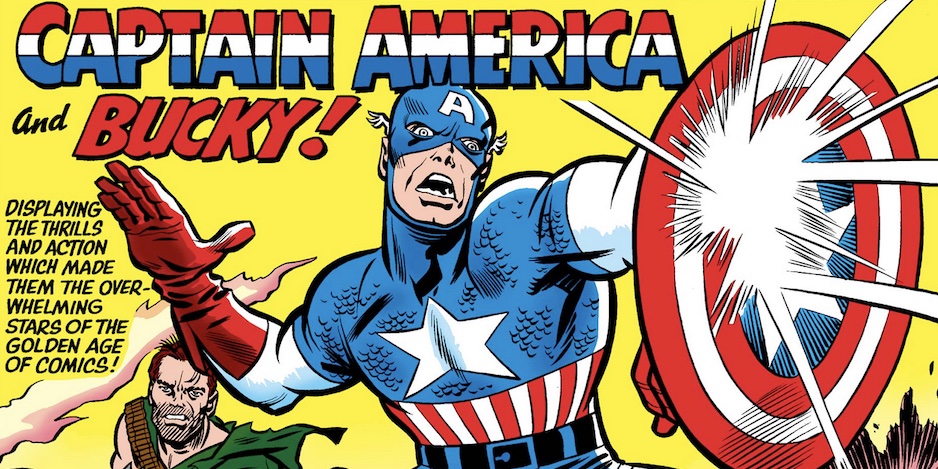
By FRED VAN LENTE
“Let’s start with the villain.”
This is how Crystal Skillman and I dramatize Joe Simon’s inspiration to create Captain America in our play (and free audiodrama) King Kirby. He had just recruited a young, incredibly talented—and incredibly fast—artist slaving away in obscurity with him at Fox Feature Syndicate (originators of Blue Beetle) to come up with superhero characters for the newly expanding Timely Comics across town.
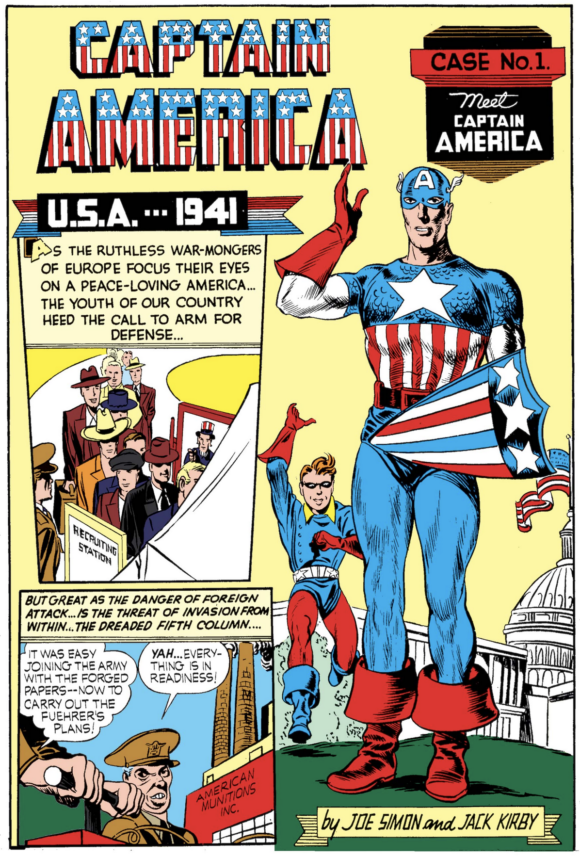
Captain America Comics #1
Simon says in his very fun autobiography The Comic Book Makers that his inspiration came from an all-too-real terror. Much of Europe had fallen to Adolf Hitler, and the future of democracy was very much in doubt. So Simon put a US flag on a WASP and sent him off to punch the Führer in the face.
It’s the aforementioned artist, Jack Kirby, who pencilled that famous cover of Captain America Comics #1. Though no one’s ever disputed that Simon is Steve Rogers’ sole creator—he has the character sketch to back it up, after all—it would be his partner who would stick with the character across three and a half decades and come to define him, with Stan Lee’s help.
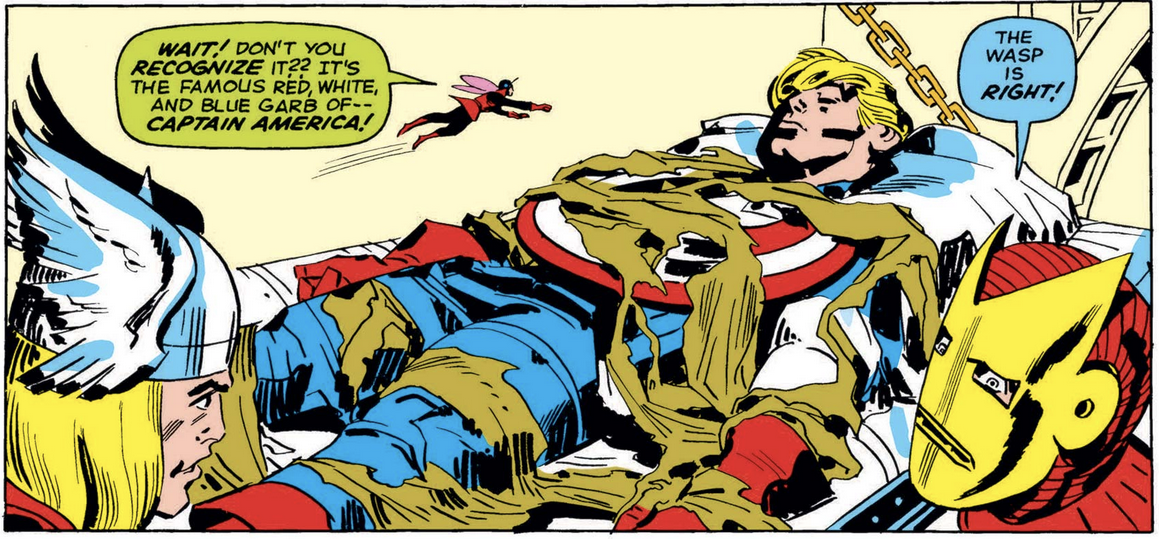
The Avengers #4
Spread across the Golden, Silver and Bronze Ages, here are the TOP 13 must-read issues of the King of Comics’ run on the Star-Spangled Avenger:
(Note that I’ve chosen, in the spirit of brevity, to include only stories where Kirby himself was the primary penciller. Thanks to the Marvel Method of comics creation, by providing layouts Kirby “wrote” the first draft of the classic “Sleepers” arc, but it was actually finished by George Tuska; the first appearance of Peggy Carter was pencilled by John Romita Sr. over Kirby’s layouts, the first Batroc by Dick Ayers over the same, and so on.)
—
13. Captain America Comics #6 (1941): “The Strange Case of Captain America and the Hangman: Who Killed Doctor Vardoff.” Jack Kirby was 23 years old when Captain America debuted: a kid, basically, and his early layouts reflect the hyperactive energy of a kid who just won’t sit down. The action of a Kirby-pencilled comic was so dynamic a single page couldn’t hope to contain it—figures literally burst out of the panel borders.
What’s the next logical step? Why, have a single image burst across two pages, of course! While the Timely era of Cap is the definition of “crude,” it’s worth noting that this story opens with the first-ever double-page splash in S&K, and, apparently, comics history.
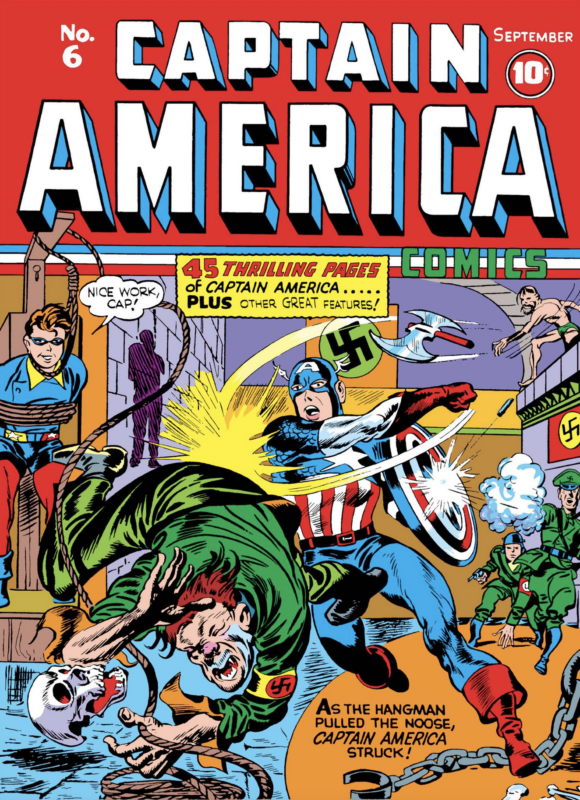
Poss. Kirby inks
There’s another interesting footnote to this story: MLJ Comics (Archie to you and me) was already not thrilled that Captain America existed, as they introduced patriotic superhero The Shield months before Steve Rogers’ debut. They were even less happy that Cap’s original triangular shield looked very much like the Shield’s tunic. And they were really annoyed that Cap was way, way more popular than the Shield or any other flag-waving do-gooder.
Even though S&K turned Cap’s shield round to appease MLJ (doing them a favor, since Cap could now throw his mighty shield, and all those who chose to oppose his shield must yield), MLJ boss John Goldwater hit the roof when he saw this story. MLJ had just debuted a new hero, the Hangman, you see, and Timely’s introduction of their own Hangman had him declaring enough is enough and threatening a lawsuit.
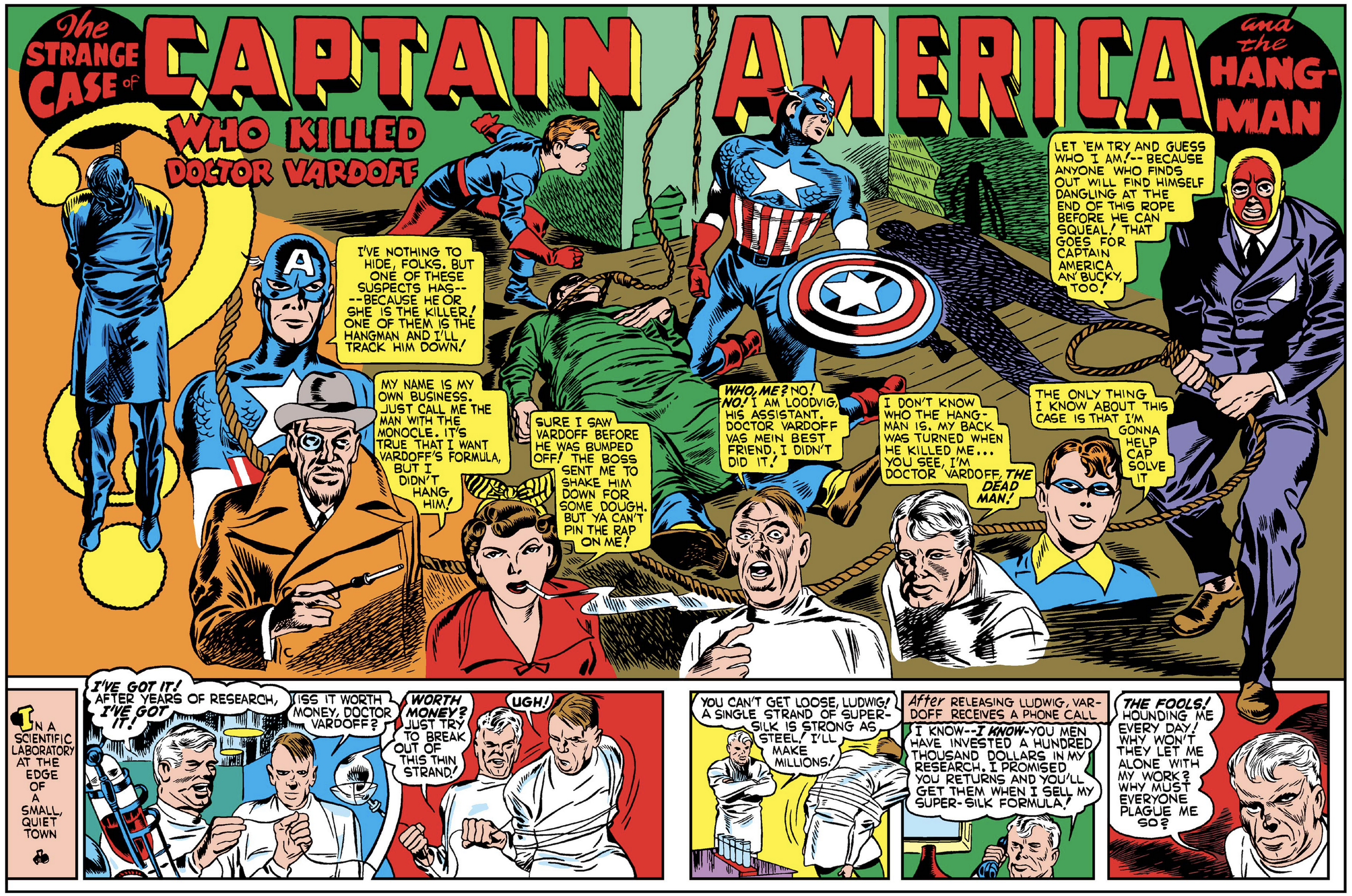
Simon inks
In The Comic Book Makers, Simon tells how he, Kirby, and Timely head Martin Goodman all had to go to MLJ offices to talk Goldwater down, pointing out that their Hangman was a villain who was killed at the end of the story and would never be seen again.
Goldwater may have had the last laugh, though: Goodman used MLJ’s Morris Coyne as an accountant, and Coyne tipped off Joe Simon that Timely wasn’t paying S&K their royalties from the million-copy selling Captain America Comics. The duo soon defected from Timely for DC, making sure Steve Rogers would not enjoy the services of either of his co-creators for the next 20 years…!
—
12. Sgt. Fury #13 (1964): “Fighting Side-by-Side with… Captain America and Bucky!” This impassioned blog post on the Kirby Museum website makes a strong argument that this done-in-one issue of the odd-duck Marvel Age war comic was the greatest showcase for Kirby’s dynamic storytelling skills.
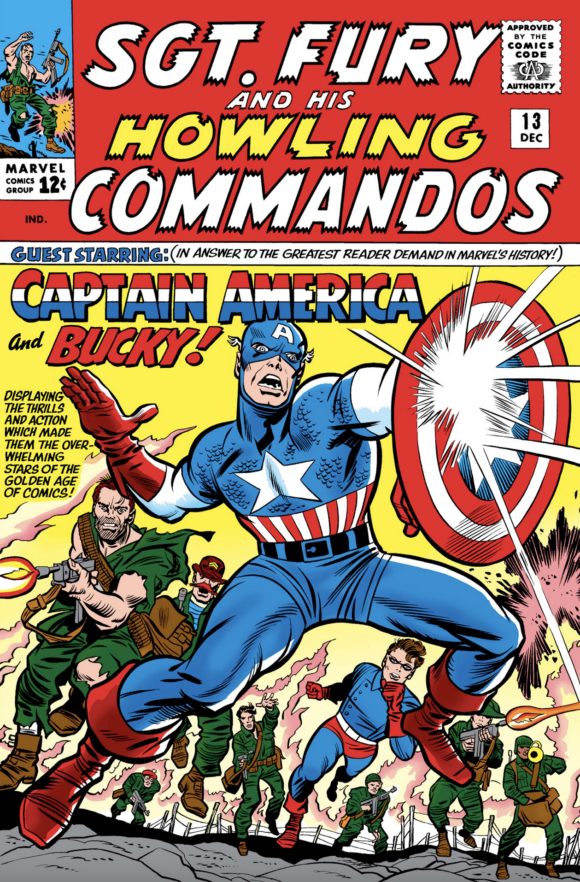
Chic Stone inks
We open with Fury getting annoyed that a London theater audience gets a bigger kick out of a newsreel depicting Cap’s exploits than his own. Then Nick unwittingly “rescues” Private Steve Rogers from a bully at a pub in a massive brawl. Fury’s fighting skill inspires Cap to send for help from the Howling Commandos after he and Bucky invade German lines on a motorcycle, part of a classic Cap trend.
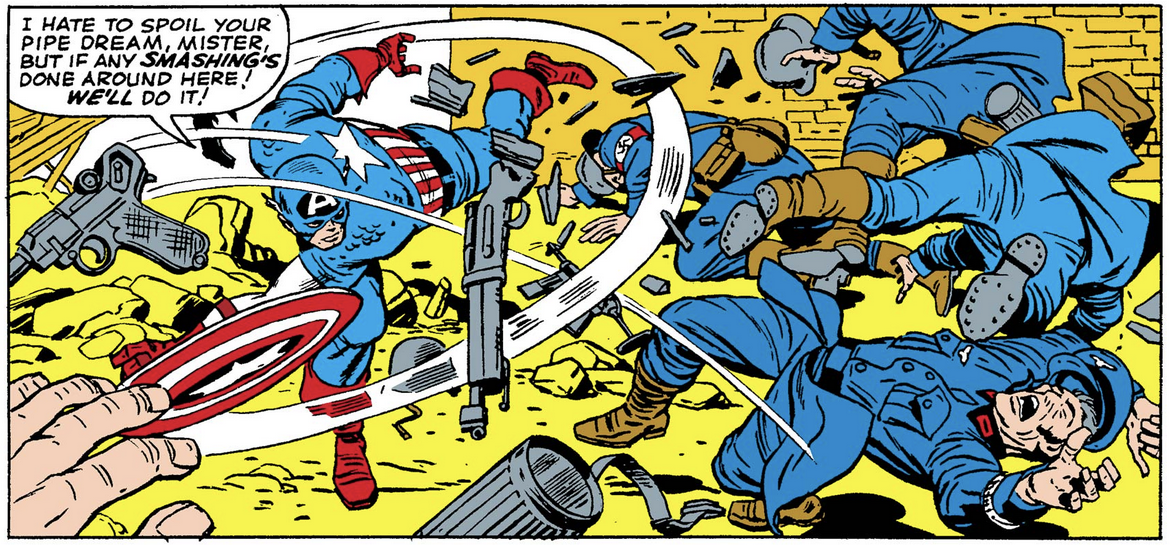
Ayers inks
Nick immediately seizes on the chance to prove he’s a better soldier than Cap. The Commandos capture a German howitzer placement and blast their way clear through the Nazi lines. They seize control of a slave laborer-filled train and ride it to where the Nazis are digging a secret tunnel to invade Britain. Unbeknownst to the Howlers, Cap and Bucky are also on the train, disguised as Nazis. They reveal themselves when the big fight breaks out. Our assembled heroes blow up the tunnel, Old Blighty is saved, Fury admits Cap isn’t the mask-wearing phony he thought he was, and I need to go lie down because I’m exhausted.
—
11. Captain America #107 (1968): “If the Past Be Not Dead—.” Sure, we’ve seen Villain-Tries-to-Drive-Hero-Crazy-with-Hallucinations before, but have we seen it with nightmarish Syd Shore inks (I mean that as a compliment) over manic Kirby layouts? The Red Skull as an NYPD beat cop? Nazis torturing Cap for the date of D-Day? A rat-faced bellhop dressed as Bucky? The introduction of world’s worst psychiatrist, Dr. Faustus, who looks so much more awesome in his original Kirby design? That amazing cover?
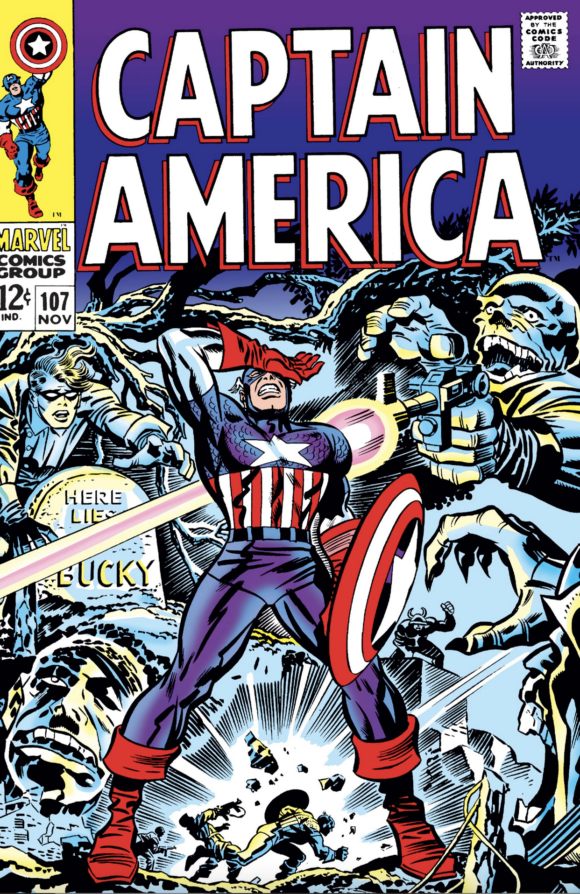
Frank Giacoia inks
And, even better, for the first time (I believe), we see what Steve Rogers would look like if he aged in real time, long before Chris Evans got slathered in makeup for the button of Endgame.
—
10. Captain America #209 (1977): “Arnim Zola—The Bio-Fanatic!!” Yes, Dan, I know, Batman has the superior rogues’ gallery of all super heroes—I think few would dispute that. The Flash, the Fantastic Four, Spider-Man — these villain sets would be in the top five (hell, the FF’s rogues have had more of their own solo series than any other hero’s villains combined), but in doing this list I decided that Captain America’s rogues have to be at least discussed as also up there. Batroc, Dr. Faustus, Baron Zemo, the Red Skull—after creating MODOK, a guy who is nothing but head, in Tales to Suspense #94 (in a lame story that isn’t worthy of this list, hey, they can’t all be winners), how is Kirby going to top that a decade later except with a guy with no head?!
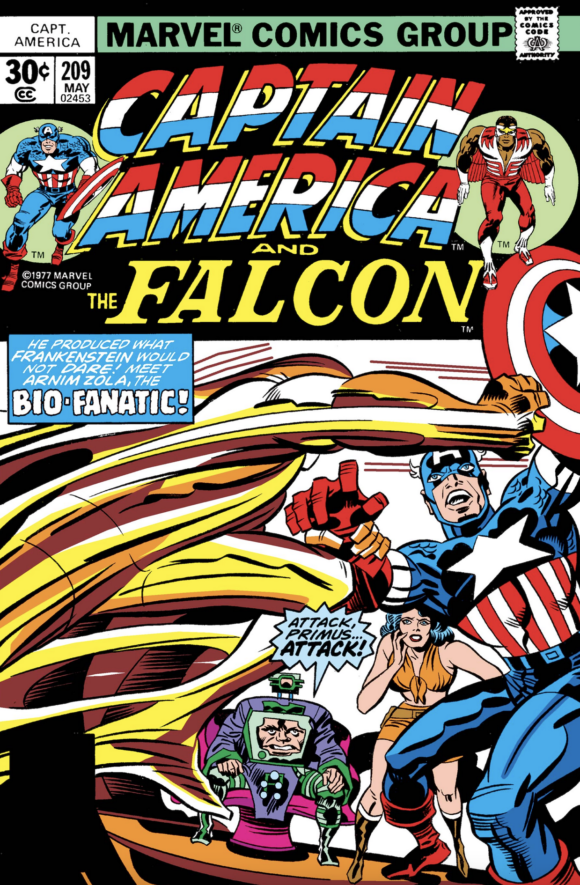
John Verpoorten inks
Hailing from Switzerland, Birthplace of the Mad Scientist®, Zola was a little dude who found the secrets to unlocking DNA hidden beneath the floor of his castle in a cast-iron box, as one does, and used it to create various horrors, such as the shoggoth-esque Doughboy and the he-man Primus. He grew a super-buff body for himself, like all these guys do, with his brain in its chest, because it’s more protected there, gosh.
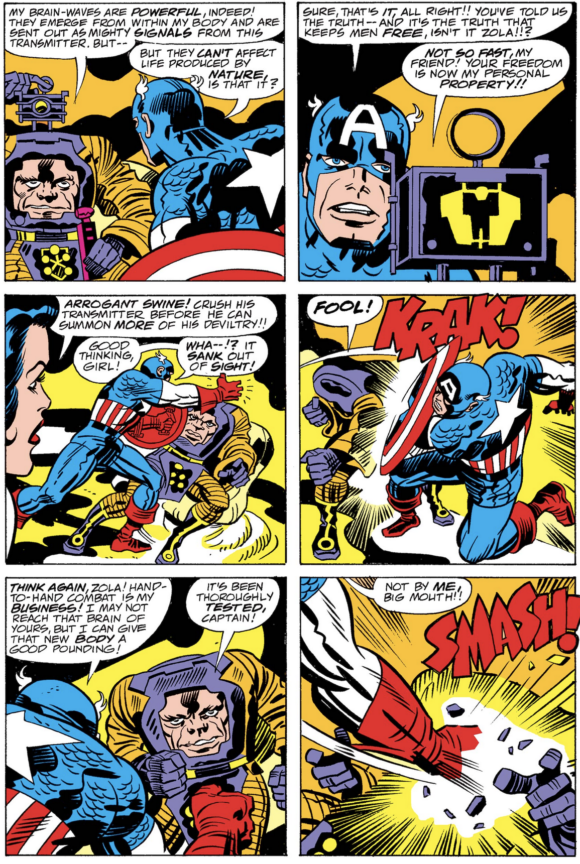
Verpoorten inks
Of course Zola also has Adolf Hitler’s brain, and of course he’s housing it in a giant beefcake wrestler’s body. Of course he wants to cut off Captain America’s face and put it on said body. Of course this is all being masterminded by the Red Skull. Kirby’s last big storyline on the title that made his rep may be completely banana-pants, but damn it’s fun.
—
9. The Avengers #7 (1964): “Their Darkest Hour!” Though Jim Steranko would do a lot more with it when he briefly took over the Captain America book from Kirby, the idea of Rick Jones trying to Jason-Todd-as-Bucky starts here. Cap flips out when Rick puts on one of Bucky’s old outfits he keeps in his closet and sniffs occasionally (OK, I made up that last part, but it’s still weird). Steve’s still got a mad-on for Baron Zemo, who sabotaged the plane that blew up his wartime partner. This makes him ripe for manipulation by Skurge, the Executioner, who shows heretofore unknown thespian skills by dressing up as an ex-Nazi wishing to reform and telling Cap where Zemo’s Amazonian hideout is.
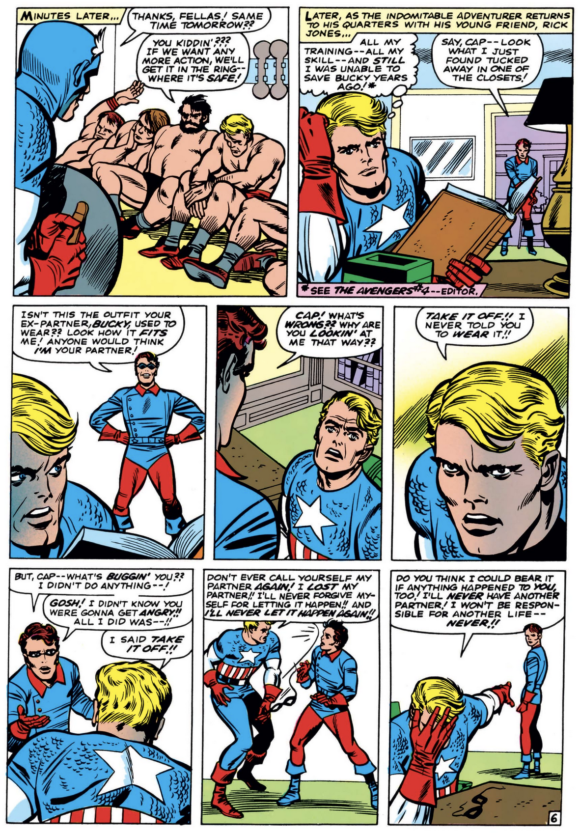
Stone inks
This is of course a trap. His teammates can’t help because Enchantress has brain-jujued Thor into attacking the other Avengers in New York, so this is essentially a Cap solo adventure before he got his own strip.
—
8. Captain America #196 (1976): “Kill-Derby.” At the risk of sounding pedantic (too late?), I am very much distinguishing “The Best” from “Most Essential” on this list. I already surveyed the former of Kirby’s 1970s Marvel work in my very-first King-oriented 13th Dimension column. The distinction I’d draw, I guess, is between comics that are just fantastic in and of themselves, and comics that are important building-blocks for a franchise’s foundation. This issue easily makes both lists for what it says about the essence of Captain America. From that earlier column:
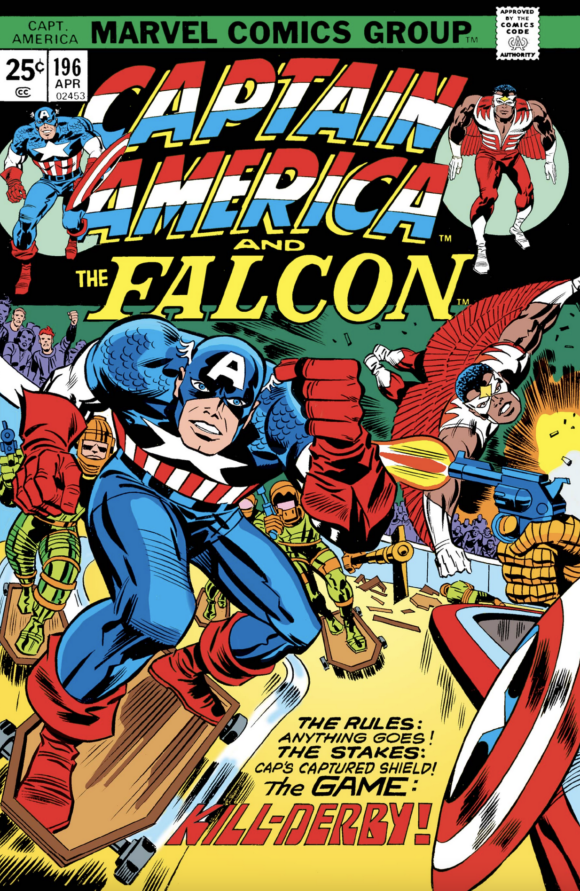
Giacoia inks
In their first long arc, SHIELD agents Rogers and Wilson go after a bunch of One-Percenters called the Elite that want to drive the working stiffs of America crazy with Madbombs so they can take over and set up an American aristocracy. Cap and Falc get captured by the ’Leet in their underground HQ and have to duel to the death on skateboards for the amusement of the blue-bloods because, Kirby. (And Rollerball.)
What particularly incenses Steve is that the bad guys have taken his shield and given it to one of their pro-fascist fighters. It’s one of the very few times Cap shakes his square-jawed squareness and channels Kirby’s own anti-fascist fury, summed up by a panel that (sadly) could have been written this morning:
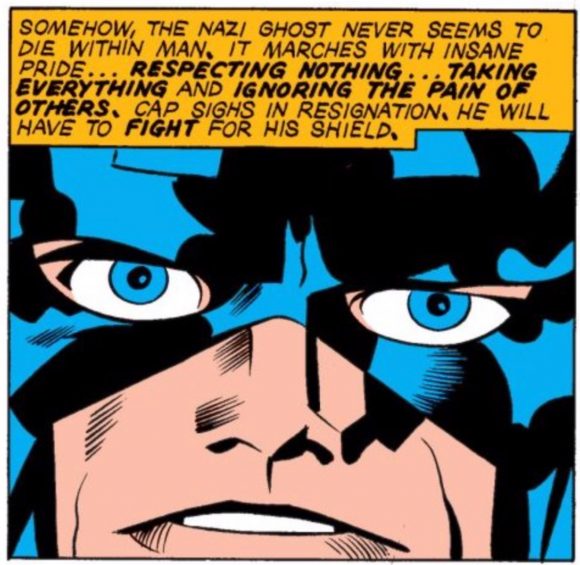
D. Bruce Berry inks
—
7. Tales of Suspense #66 (1965): “The Fantastic Origin of the Red Skull.” For about nine issues, Cap’s Tales of Suspense strip went back in time for World War II adventures, primarily, I suspect, to re-introduce the Red Skull to ’60s readers.
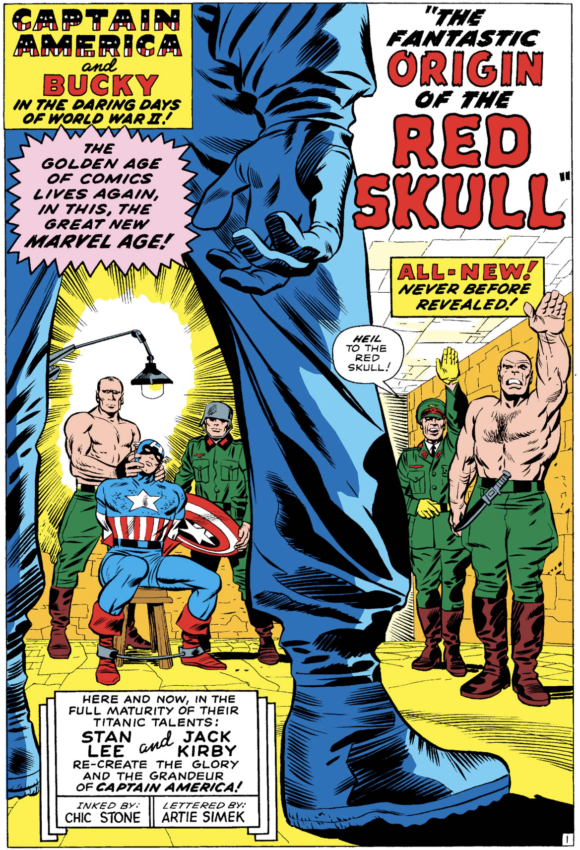
The Skull is one of those dream-logic characters that doesn’t make any rational sense (why a skull? why red?) but works perfectly when contrasted with the apple pie-earnestness of Steve Rogers, much like how flamboyant chaos agent the Joker is the perfect complement to the mysterious, hyper-organized Batman.
Skull’s perverse Silver Age origin, that he’s just a random bellhop (Cap has terrible luck with bellhops for some reason) molded like evil clay by Adolf Hitler, matches this bizarre character. Furthermore, his expressive, uh, skull, is a terrific showcase for Kirby’s cartooning skill to warp anatomy for emotional effect.
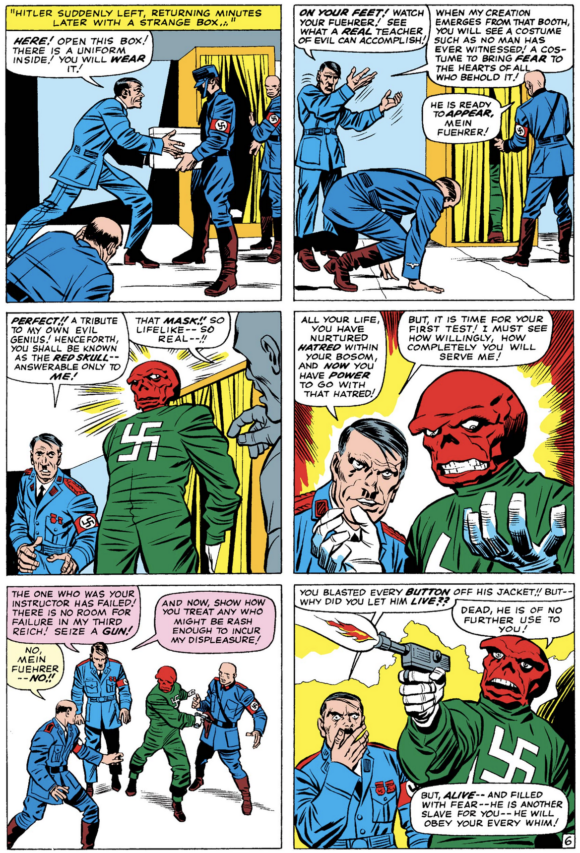
Stone inks
It’s worth noting that Kirby always attributed the Red Skull’s creation to writer Ed Herron, one of the freelancers he and Simon hired to help out on Captain America Comics #1 after receiving a punishing deadline from Goodman. (Goodman vacillated between fearing getting sued by Hitler for the punch-cover, and getting that same cover out as soon as possible in case Hitler was killed in the war, rendering it obsolete.)
Herron was a prolific Golden Age scribe best known for co-creating Captain Marvel Jr. at Fawcett. He met Kirby and Simon when they all worked at Fox. Herron helped script many of the King’s 1950s DC projects, like Green Arrow and Challengers of the Unknown.
—
6. Marvel Treasury Special Featuring Captain America’s Bicentennial Battles (1976). Updated from the aforementioned 1970s Kirby Marvel column: The gigantic Treasury Special format was pretty much invented for Jack Kirby, and while you can find the story elsewhere, I would strongly recommend sifting through the bins of back-issue dealers at your local con because it really needs to be appreciated in the original giant size, which is full-on Kirby all up in your face.
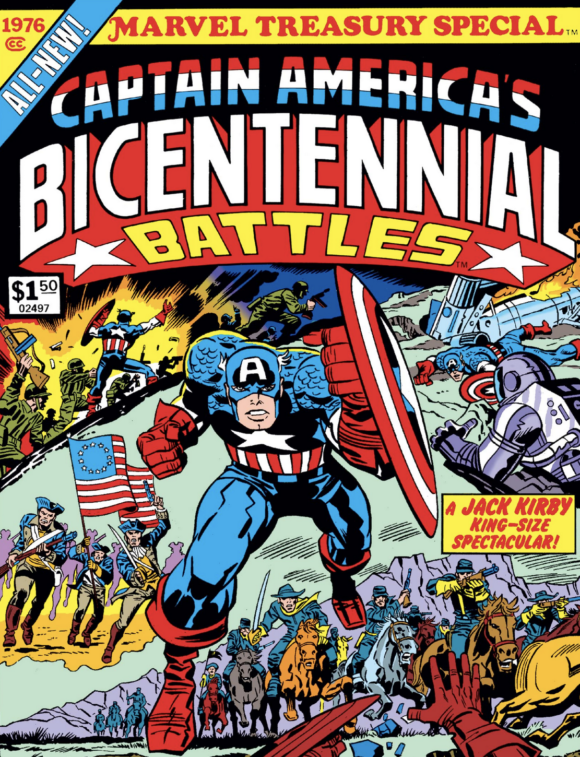
Marie Severin and John Romita inks
Must be a slow day at Avengers Mansion, because Cap goes to visit a random cosmic mystic named Mister Buda, who sends him on a crazy journey throughout time to reconnect with The True Meaning of America. The story makes no goddamn sense but is nevertheless extremely awesome. It’s worth it to see Barry Windsor-Smith inking Kirby in the opening pages, which looks as amazing as you might think, and for when Cap rescues his co-creator as a newsie.
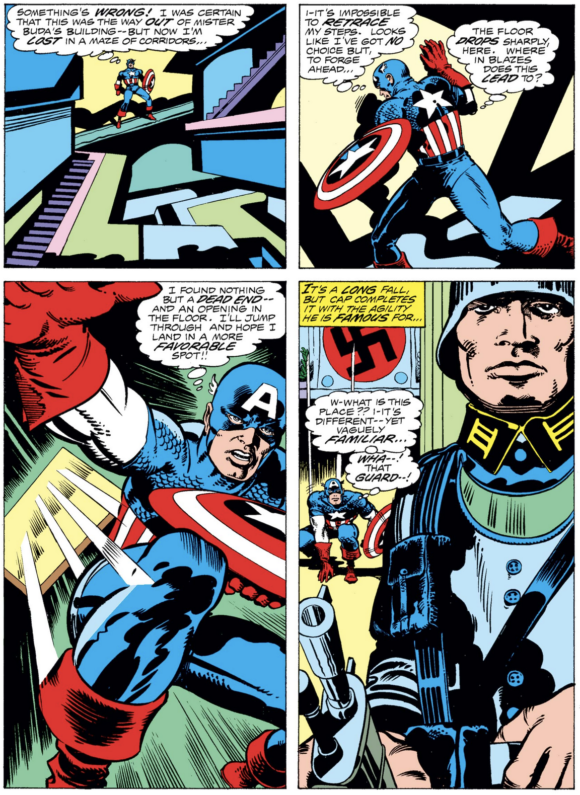
BWS inks
—
5. Captain America Comics #1 (1940): “Meet Captain America.” Captain America arguably has the third-best origin story of the Golden Age, behind Batman and Superman. The best superhero characters work on a very basic, serpent-brain wish-fulfillment level: child orphaned by crime fights crime; immigrant child uses his unique talents to defend adopted countr—er, planet; wimpy dude wants to serve his country, is denied, then miraculously gets a second chance with a super-soldier serum.
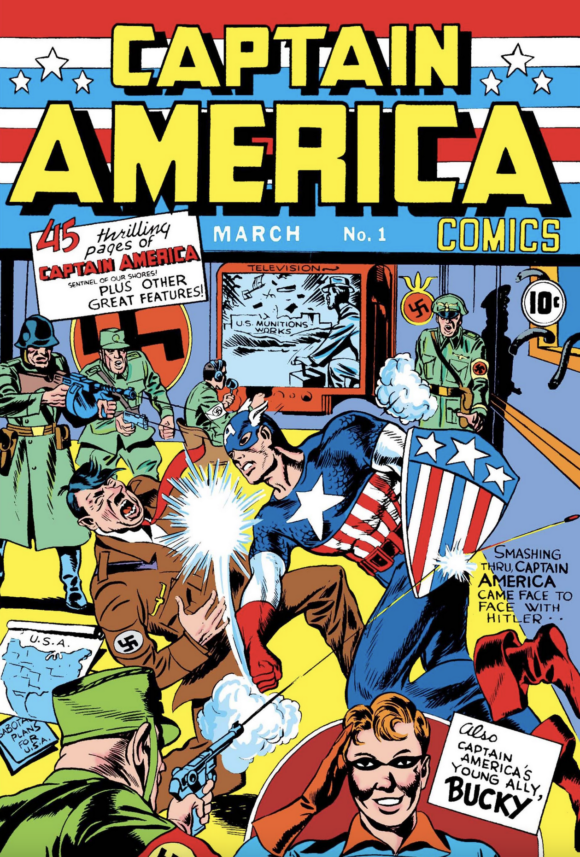
Kirby and Simon pencils, Simon inks
You know a superhero has a great origin story when creators keep returning to it again and again (looking at you, Bats). Kirby told Cap’s origin a couple of times—arguably the best one is the one he did with Stan Lee in Tales of Suspense #63, but, again, I’m trying to only list “Essential” tales, and you don’t get much more essential than the character’s very first appearance. Already you see the dynamism in figure work and layouts that would make Kirby a legend.
—
4. The Avengers #4 (1964): “Captain America Joins…The Avengers!” Sure, Captain America maybe has the third-best origin of the Golden Age, but he also has one of the greatest origins of the Silver Age, with the masterstroke of making him Rip Van Winkle with a shield. “Man out of time” is a great story hook in any genre—The Boys made hilariously effective use of it with their Season 3 parody Soldier Boy—and we see it start with Cap getting unfrozen by the Avengers here.
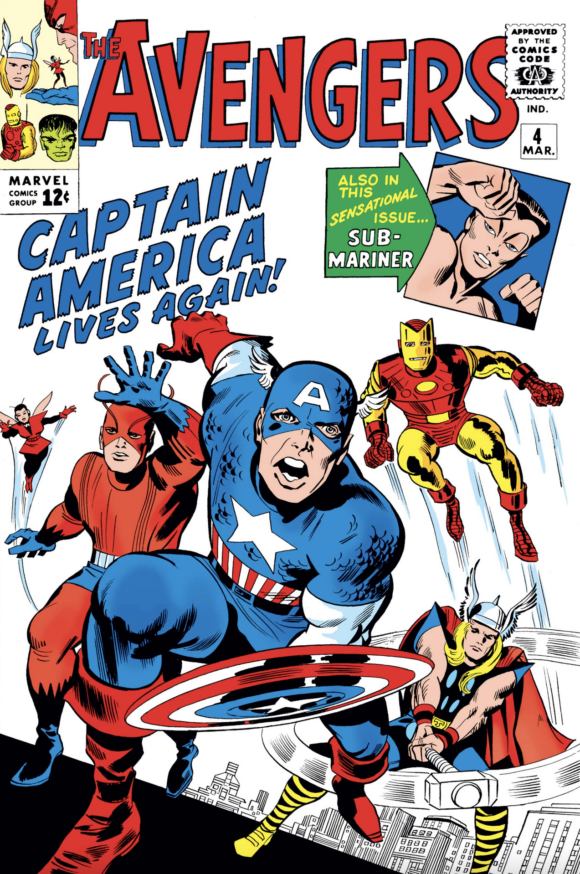
George Roussos inks
Then, of course, the Assemblers promptly get turned to stone upon docking in New York harbor, letting Cap wander around by himself, awing at the UN Secretariat, television, and other marvels of the 1960s. Eventually he gets roped in by perennially useful idiot Rick Jones and the Teen Brigade into tracking down the Mad Petrifier. No, it’s not the Grey Gargoyle—good guess, though—but an alien being blackmailed by the Sub-Mariner into zapping superheroes with an enrockifying-ray. Sure, that was my second guess.
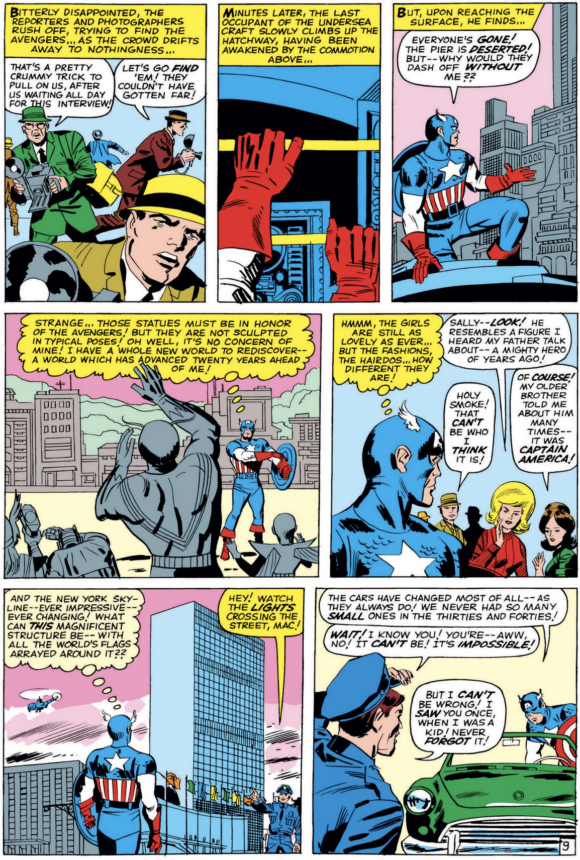
Roussos inks
Yes, Marvel would have to figure out a way to retcon away the failed 1950s “Commie Smasher” revival to explain why the real Cap was in ice since 1945 or so. And Serpent Crown-related amnesia would be needed to explain why Namor doesn’t recognize his former All-Winners Squad teammate after freeing him from a block of ice. Of course, that doesn’t explain why Captain America doesn’t recognize Namor, but, hey, it’s all good! My favorite comics writing trick is to turn continuity oopsies into compelling stories.
—
3-1. Tales of Suspense #79-81 (1966): “The Red Skull Lives!” / “He Who Holds the Cosmic Cube” / “The Red Skull Supreme!” Jack Kirby turned 49 in 1966, and was at the height of his creative powers. This is the year of the Galactus Trilogy, the introduction of the Olympians to Thor, and the high-water mark on the title that first made his name.
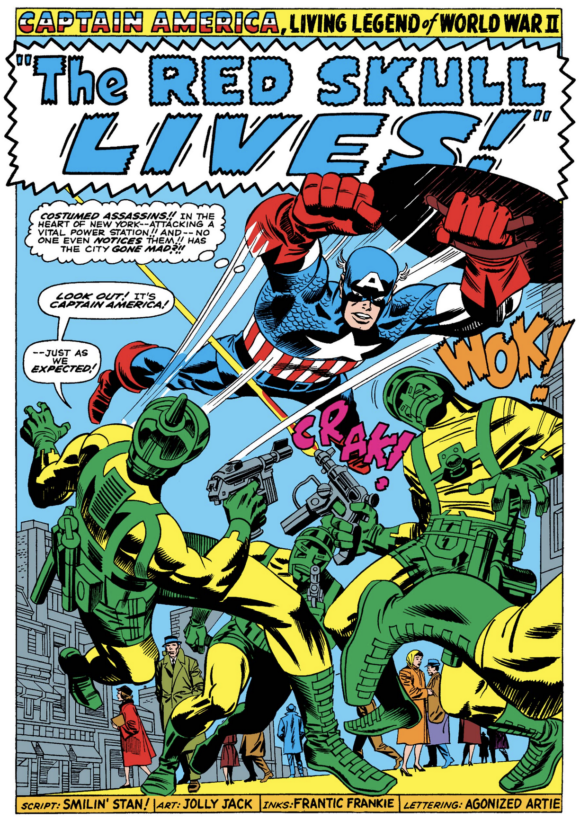
Tales of Suspense #79, Giacoia inks
Cap has been kicking around the Swinging Sixties for two years now, which, by all laws of Superhero Physics, means that his arch-nemesis can’t be too far behind. We learn that the Red Skull was dug out by AIM beekeepers after getting put in suspended animation during WWII by some conveniently stored gas released during a post-Captain America fistfight bombing raid. Stupidly thinking they can manipulate the Skull for their own ends, AIM of course gets betrayed by the Skull the first chance he gets. He steals their the Cosmic Cube, the ultimate Plot Device that turns his evil thoughts into reality.
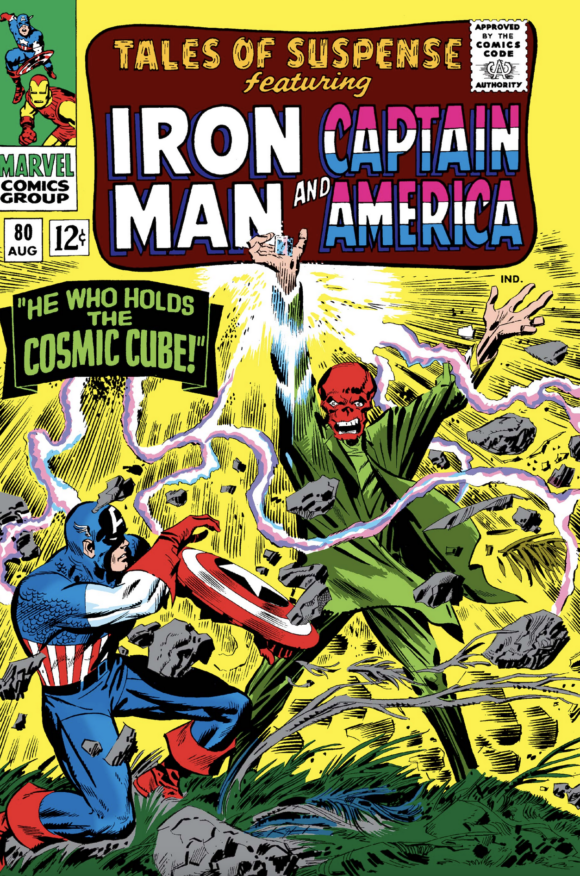
Don Heck inks
The only man around to stop him is Steve Rogers, who has to use good-old fashioned pluck and cunning to defeat this mad god, thereby proving the most fundamental American tenet of all — that “We, the People” can stand up to almost anything.
It’s a bummer that the movie version reduced “the Tesseract” to a generic blue-light-emitting knickknack, but lucky you, the original, superior comics are always there, waiting to be read.
—
MORE
— The TOP 13 Issues of JACK KIRBY’s 1970s Return to MARVEL — RANKED. Click here.
— The Top 13 JACK KIRBY KID GANGS — RANKED. Click here.
—
13th Dimension contributor Fred Van Lente is an award-winning, New York Times-bestselling comics writer, as well as an occasional novelist, teacher, and playwright. Sign up for updates on his upcoming projects and check out the trailer for his comics-writing course at his web site, fredvanlente.com.

August 12, 2024
It is sad that so many Americans have reverted to anti semitism. The nazi ghost.
August 13, 2024
We are living (again) in very dangerous times all over the world. It’s not just here where antisemitism is growing.